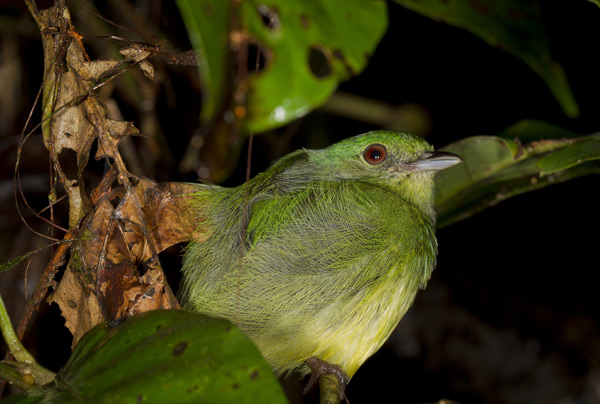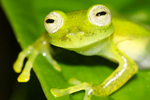 A female blue crowned manakin (Lepidothrix coronata) is one of over a thousand known bird species in Madidi National Park. Photo by: Mileniusz Spanowicz/WCS. |
With over 90 species of bat, 50 species of snake, 300 fish, 12,000 plants, and 11 percent of the world’s bird species, Madidi National Park in Bolivia may be the world’s most biodiverse place, according to new surveys by the the Bolivian Park Service (SERNAP) with aid from the Wildlife Conservation Society (WCS).
Located in northwest Bolivia, Madidi National Park covers 19,000 square kilometers (7,335 square miles), an area slightly smaller than Israel. Decades of work by over 50 researchers have discovered 1,088 birds in the park alone, more than all the bird species in the entire U.S., and over 200 mammal species, including at least six cat species and possibly two more.
 A parrot snake (Leptophis ahaetulla), one of at least 50 species of snake in Madidi National Park. Photo Credit: Mileniusz Spanowicz/WCS. |
“With Madidi’s almost 6,000-meter (19,685 feet) altitudinal range, no other protected area captures the diversity of South American habitats that pushes these numbers through the ceiling,” explains Robert Wallace, WCS’s Madidi Landscape Program Director in a press release.
Still, much of what could the park’s most biodiverse ecosystems—montane and cloud forests—remain unsurveyed. Cloud forests often contain high levels of species found no-where else.
“This important compendium emphasizes just how poorly known the cloud forests of the Tropical Andes really are. Apart from their biodiversity and wildlife importance, they are critical from a watershed management perspective and are aesthetically beautiful,” Cristián Samper, President and CEO of WCS says. The biggest threat to these montane forests is climate change, according to the group.
Madidi is not the only park that has been described as a contender for the world’s most biodiverse. Other protected areas include Manu National Park in Peru and Yasuni National Park in Ecuador. Notably all three of these, including Madidi, are located in the western Amazon.
The announcement was made at the IUCN World Conservation Congress in Jeju, South Korea.
 Madidi cloud forest at dawn. A huge range of altitudes contributes to the park’s incredible biodiversity. Photo by: Mileniusz Spanowicz/WCS. |
 An unidentified butterfly. Photo by: Mileniusz Spanowicz/WCS. |
 A young harpy eagle (Harpia harpyja), considered Near Threatened by the IUCN Red List. These massive raptors prey on monkeys. Photo by: Mileniusz Spanowicz/WCS. |
 Black-faced spider monkey (Ateles chamek) in Madidi, considered Endangered. Photo by: Mileniusz Spanowicz/WCS. |
 Unidentified forest toad. Photo by: Mileniusz Spanowicz/WCS. |
 Young wattled jacana (Jacana jacana). Photo by: Mileniusz Spanowicz/WCS. |
 The king of the Amazon: a male jaguar (Panthera onca) in Madidi, considered Near Threatened. Photo by: Mileniusz Spanowicz/WCS. |
 The Amazon’s biggest animal: the lowland tapir (Tapirus terrestris), considered Vulnerable. Photo by: Mileniusz Spanowicz/WCS. |
 Palkachupa cotinga (Phibalura boliviana)was rediscovered in 2000 after missing for 98 years. Photo by: Mileniusz Spanowicz/WCS. |
 Forest floor. Photo by: Mileniusz Spanowicz/WCS. |
Related articles
Teetering on the edge: the world’s 100 most endangered species (photos)

(09/10/2012) From the Baishan fir (five left in the world) to the Sumatran rhino (around 250), a new report highlights the world’s top 100 most endangered species, according to the the International Union for Conservation of Nature (IUCN) and the Zoological Society of London (ZSL). The list spans the taxonomic gamut, from fungi (Cryptomyces maximus) to amphibians (the Table Mountain ghost frog) to flowers (the Cayman Islands ghost orchid) and much more (see full list at the end of the article).
Diversity helps ecosystems cope with stress
(09/07/2012) Ecosystems with higher levels of biodiversity tend to better cope with more stress than those with less biodiversity, finds a new study published in Ecology Letters.
One extinction leads to another…and another

(08/28/2012) A new study in Biology Letters demonstrates that altering the relationship between a predator and its prey can cause wide-ranging ripple effects through an ecosystem, including unexpected extinctions. Species help each other, directly or indirectly, which scientists refer to as mutualism or commensalism. For example, a species’ success may rely not only upon the survival of its food source, but may also indirectly rely upon the survival of more distantly related species.
Private reserve safeguards newly discovered frogs in Ecuadorian cloud forest

(08/28/2012) Although it covers only 430 hectares (1,063 acres) of the little-known Chocó forest in Ecuador, the private reserve las Gralarias in Ecuador is home to an incredible explosion of life. Long known as a birder’s paradise, the Reserva las Gralarias is now making a name for itself as a hotspot for new and endangered amphibians, as well as hundreds of stunning species of butterfly and moth. This is because the reserve is set in the perfect place for evolution to run wild: cloud forest spanning vast elevational shifts. “The pacific slope cloud forests […] are among the most endangered habitats in the world,” explains Reserva las Gralarias’ founder, Jane Lyons, in a recent interview with mongabay.com.
Scientists discover beautiful new insect species after stumbling upon photos on Flickr
(08/09/2012) Scientists have discovered a previously unknown species of lacewing insect after stumbling upon a series of photos posted on Flickr®, according to a paper published in the journal ZooKeys.
3000 new species of amphibians discovered in 25 years
(07/31/2012) The number of amphibians described by scientists now exceeds 7,000, or roughly 3,000 more than were known just 25 years ago, report researchers in Berkeley.
Half of tropical forest parks losing biodiversity

(07/25/2012) Governments have set up protected areas, in part, to act as reservoirs for our Earth’s stunning biodiversity; no where is this more true than in the world’s tropical forests, which contain around half of our planet’s species. However a new study in Nature finds that wildlife in many of the world’s rainforest parks remains imperiled by human pressures both inside and outside the reserves, threatening to undercut global conservation efforts. Looking at a representative 60 protected areas across 36 tropical nations, the scientists found that about half the parks suffered an “erosion of biodiversity” over the last 20-30 years.